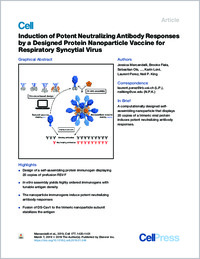Induction of potent neutralizing antibody responses by a designed protein nanoparticle accine for respiratory syncytial virus
- Marcandalli, Jessica Institute for Research in Biomedicine (IRB), Faculty of Biomedical Sciences, Università della Svizzera italiana, Switzerland -
- Fiala, Brooke Department of Biochemistry, University of Washington, Seattle, USA - Institute for Protein Design, University of Washington, Seattle, USA
- Ols, Sebastian Department of Medicine Solna, Division of Immunology and Allergy, Karolinska Institutet, Stockholm, Sweden - Center for Molecular Medicine, Karolinska Institutet, Stockholm, Sweden
- Perotti, Michela Institute for Research in Biomedicine (IRB), Faculty of Biomedical Sciences, Università della Svizzera italiana, Switzerland - Institute of Microbiology, ETH Zürich, Switzerland
- de van der Schueren, Willem Clinical Research Division, Fred Hutchinson Cancer Research Center, Seattle, USA - Bluebird Bio, Seattle, USA
- Snijder, Joost Department of Biochemistry, University of Washington, Seattle, USA
- Hodge, Edgar Department of Medicinal Chemistry, University of Washington, Seattle, USA
- Benhaim, Mark Department of Medicinal Chemistry, University of Washington, Seattle, USA
- Ravichandran, Rashmi Department of Biochemistry, University of Washington, Seattle, USA - Institute for Protein Design, University of Washington, Seattle, USA
- Carter, Lauren Department of Biochemistry, University of Washington, Seattle, USA - Institute for Protein Design, University of Washington, Seattle, USA
- Sheffler, Will Department of Biochemistry, University of Washington, Seattle, USA - Institute for Protein Design, University of Washington, Seattle, USA
- Brunner, Livia Vaccine Formulation Laboratory, University of Lausanne, Switzerland
- Lawrenz, Maria Vaccine Formulation Institute, Godalming, UK
- Dubois, Patrice Vaccine Formulation Institute, Godalming, UK
- Lanzavecchia, Antonio Institute for Research in Biomedicine (IRB), Faculty of Biomedical Sciences, Università della Svizzera italiana, Switzerland
- Sallusto, Federica Institute for Research in Biomedicine (IRB), Faculty of Biomedical Sciences, Università della Svizzera italiana, Switzerland - Institute of Microbiology, ETH Zürich, Switzerland
- Lee, Kelly K. Department of Medicinal Chemistry, University of Washington, Seattle, USA - Biological Physics Structure and Design Program, University of Washington, Seattle, USA
- Veesler, David Department of Biochemistry, University of Washington, Seattle, USA
- Correnti, Colin E. Clinical Research Division, Fred Hutchinson Cancer Research Center, Seattle, USA
- Stewart, Lance J. Department of Biochemistry, University of Washington, Seattle, USA - Institute for Protein Design, University of Washington, Seattle, USA
- Baker, David Department of Biochemistry, University of Washington, Seattle, USA - Institute for Protein Design, University of Washington, Seattle, USA - Howard Hughes Medical Institute, University of Washington, Seattle, USA
- Loré, Karin Department of Medicine Solna, Division of Immunology and Allergy, Karolinska Institutet, Stockholm, Sweden - Center for Molecular Medicine, Karolinska Institutet, Stockholm, Sweden
- Perez, Laurent Institute for Research in Biomedicine (IRB), Faculty of Biomedical Sciences, Università della Svizzera italiana, Switzerland - European Virus Bioinformatics Center, Jena, Germany
- King, Neil P. Department of Biochemistry, University of Washington, Seattle, USA - Institute for Protein Design, University of Washington, Seattle, USA
-
07.03.2019
Published in:
- Cell. - 2019, vol. 177, no. 6, p. 1420-1431.e17
Computational protein design
Self-assembly
Vaccines
Respiratory syncytial virus
Nanoparticles
Neutralizing antibodies
English
Respiratory syncytial virus (RSV) is a worldwide public health concern for which no vaccine is available. Elucidation of the prefusion structure of the RSV F glycoprotein and its identification as the main target of neutralizing antibodies have provided new opportunities for development of an effective vaccine. Here, we describe the structure-based design of a self-assembling protein nanoparticle presenting a prefusion-stabilized variant of the F glycoprotein trimer (DS-Cav1) in a repetitive array on the nanoparticle exterior. The two-component nature of the nanoparticle scaffold enabled the production of highly ordered, monodisperse immunogens that display DS-Cav1 at controllable density. In mice and nonhuman primates, the full-valency nanoparticle immunogen displaying 20 DS-Cav1 trimers induced neutralizing antibody responses ∼10-fold higher than trimeric DS-Cav1. These results motivate continued development of this promising nanoparticle RSV vaccine candidate and establish computationally designed two-component nanoparticles as a robust and customizable platform for structure-based vaccine design.
- Language
-
- English
- Classification
- Pathology, clinical medicine
- License
- Open access status
- hybrid
- Identifiers
-
- RERO DOC 327030
- DOI 10.1016/j.cell.2019.01.046
- ARK ark:/12658/srd1318938
- Persistent URL
- https://n2t.net/ark:/12658/srd1318938
Statistics
Document views: 245
File downloads:
- Fulltext: 335
